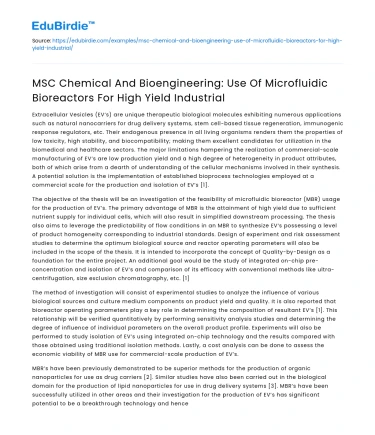Extracellular Vesicles (EV’s) are unique therapeutic biological molecules exhibiting numerous applications such as natural nanocarriers for drug delivery systems, stem cell-based tissue regeneration, immunogenic response regulators, etc. Their endogenous presence in all living organisms renders them the properties of low toxicity, high stability, and biocompatibility; making them excellent candidates for utilization in the biomedical and healthcare sectors. The major limitations hampering the realization of commercial-scale manufacturing of EV’s are low production yield and a high degree of heterogeneity in product attributes, both of which arise from a dearth of understanding of the cellular mechanisms involved in their synthesis. A potential solution is the implementation of established bioprocess technologies employed at a commercial scale for the production and isolation of EV’s [1].
The objective of the thesis will be an investigation of the feasibility of microfluidic bioreactor (MBR) usage for the production of EV’s. The primary advantage of MBR is the attainment of high yield due to sufficient nutrient supply for individual cells, which will also result in simplified downstream processing. The thesis also aims to leverage the predictability of flow conditions in an MBR to synthesize EV’s possessing a level of product homogeneity corresponding to industrial standards. Design of experiment and risk assessment studies to determine the optimum biological source and reactor operating parameters will also be included in the scope of the thesis. It is intended to incorporate the concept of Quality-by-Design as a foundation for the entire project. An additional goal would be the study of integrated on-chip pre-concentration and isolation of EV’s and comparison of its efficacy with conventional methods like ultra-centrifugation, size exclusion chromatography, etc. [1]
Save your time!
We can take care of your essay
- Proper editing and formatting
- Free revision, title page, and bibliography
- Flexible prices and money-back guarantee
The method of investigation will consist of experimental studies to analyze the influence of various biological sources and culture medium components on product yield and quality. It is also reported that bioreactor operating parameters play a key role in determining the composition of resultant EV’s [1]. This relationship will be verified quantitatively by performing sensitivity analysis studies and determining the degree of influence of individual parameters on the overall product profile. Experiments will also be performed to study isolation of EV’s using integrated on-chip technology and the results compared with those obtained using traditional isolation methods. Lastly, a cost analysis can be done to assess the economic viability of MBR use for commercial-scale production of EV’s.
MBR’s have been previously demonstrated to be superior methods for the production of organic nanoparticles for use as drug carriers [2]. Similar studies have also been carried out in the biological domain for the production of lipid nanoparticles for use in drug delivery systems [3]. MBR’s have been successfully utilized in other areas and their investigation for the production of EV’s has significant potential to be a breakthrough technology and hence warrants detailed study. Multiple approaches for isolation of EV’s and the use of microfluidics for the same have also been reported [4]. Thus, there is a compelling case to study the integration of microfluidic bioreactor with on-chip technology to achieve the goal of sustainable and techno-economically viable large-scale production of EV’s.
References
- Paganini, Carolina, et al. 'Scalable production and isolation of extracellular vesicles: available sources and lessons from current industrial bioprocesses.' Biotechnology journal (2019): 1800528.
- Capretto, Lorenzo, et al. 'Microfluidic and lab-on-a-chip preparation routes for organic nanoparticles and vesicular systems for nanomedicine applications.' Advanced drug delivery reviews 65.11-12 (2013): 1496-1532.
- Maeki, Masatoshi, et al. 'Advances in microfluidics for lipid nanoparticles and extracellular vesicles and applications in drug delivery systems.' Advanced drug delivery reviews 128 (2018): 84-100.
- Gholizadeh, Shima, et al. 'Microfluidic approaches for isolation, detection, and characterization of extracellular vesicles: current status and future directions.' Biosensors and Bioelectronics 91 (2017): 588-605.
Did you like this example?
Make sure you submit a unique essay
Our writers will provide you with an essay sample written from scratch: any topic, any deadline, any instructions.
Cite this paper
-
APA
-
MLA
-
Harvard
-
Vancouver
MSC Chem and Bioengineering: Microfluidic Bioreactors for High Yield.
(2022, February 18). Edubirdie. Retrieved April 3, 2025, from https://hub.edubirdie.com/examples/msc-chemical-and-bioengineering-use-of-microfluidic-bioreactors-for-high-yield-industrial/
“MSC Chem and Bioengineering: Microfluidic Bioreactors for High Yield.” Edubirdie, 18 Feb. 2022, hub.edubirdie.com/examples/msc-chemical-and-bioengineering-use-of-microfluidic-bioreactors-for-high-yield-industrial/
MSC Chem and Bioengineering: Microfluidic Bioreactors for High Yield. [online].
Available at: <https://hub.edubirdie.com/examples/msc-chemical-and-bioengineering-use-of-microfluidic-bioreactors-for-high-yield-industrial/> [Accessed 3 Apr. 2025].
MSC Chem and Bioengineering: Microfluidic Bioreactors for High Yield [Internet]. Edubirdie.
2022 Feb 18 [cited 2025 Apr 3].
Available from: https://hub.edubirdie.com/examples/msc-chemical-and-bioengineering-use-of-microfluidic-bioreactors-for-high-yield-industrial/
copy






 Stuck on your essay?
Stuck on your essay?

